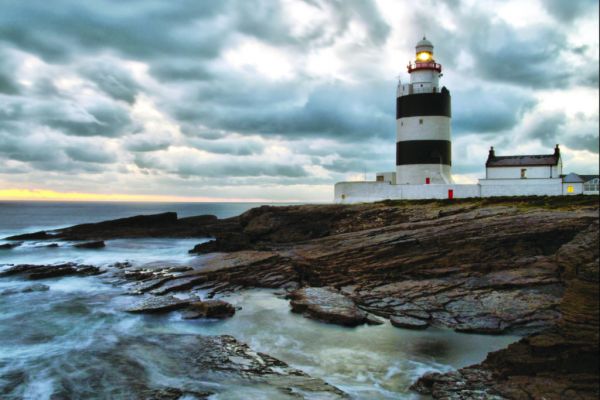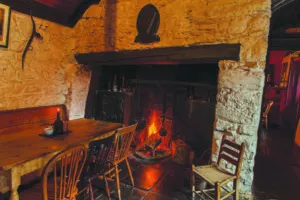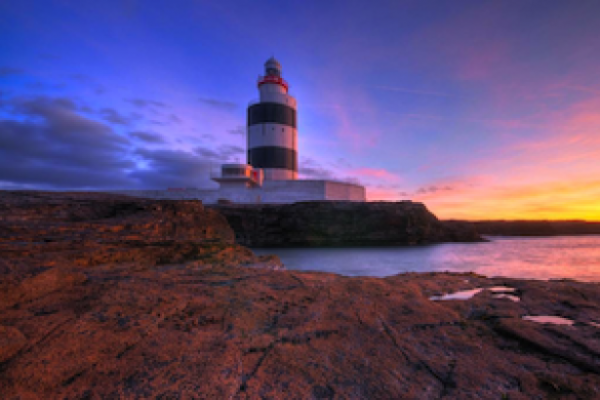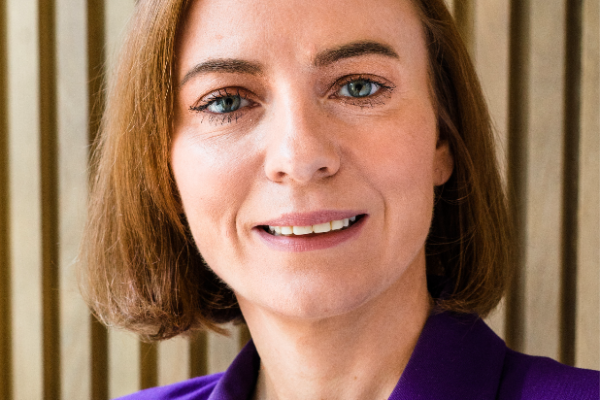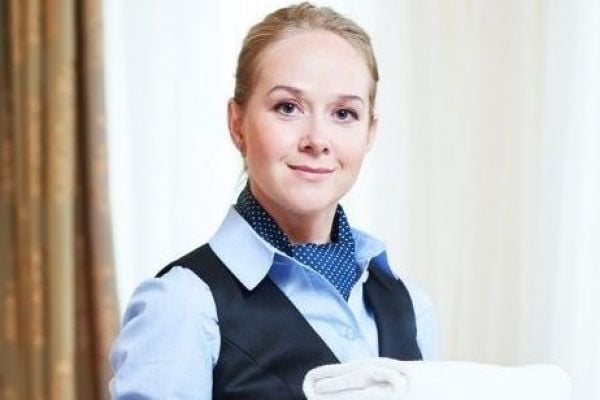In the second of our series of reports exploring how the hospitality sector is faring in the regions of Ireland, ANDREW JENNINGS travelled to the south-east coast to investigate whether the warm winds of the country’s reported economic recovery are being felt by the hotels, pubs and restaurants in the region.
**************************************************************************************************************************************************
"The Wild Atlantic Way – it's an incredible thing," Paul Flynn (pictured below), chef and owner of the Tannery Restaurant, Townhouse and Cookery School in Dungarvan, Co. Waterford, tells me as he lifts an oversized roast out of the oven, in preparation for Saturday-evening service at his award-winning eatery.
Patrolling the floor of his cookery-school kitchen, he adds, "It is the simplest and most effective piece of marketing that has ever been done for tourism in this country, and it is also an absolute bugbear of mine."
Flynn’s sudden change in manner is obvious. He stops in his tracks, places his hands down firmly on the kitchen counter and laments, "It is plainly ridiculous that it stops where it does in Kinsale and does not come through into Waterford. The obvious thing to do is extend it, as it would give a huge lift to Waterford, but they will not do it, which is a typically Irish thing to do."
The Tannery owner is not alone in his sentiments about the Wild Atlantic Way’s absence from the Waterford coastline. In fact, almost every hospitality business and tourism operator to whom I speak on my visit to the south-east is rather bewildered by Fáilte Ireland’s decision to put a full stop on the touring route at Kinsale, in West Cork.
"We did lobby extensively to try and get the Wild Atlantic Way extended to include Waterford, which is on the Atlantic," reveals Adriaan Bartels, general manager at the five-star Cliff House Hotel, located in the pretty seaside village of Ardmore (pictured below).
"There is also the South-East Coastal Route, currently in existence, which could easily have been renamed. In fact, Fáilte Ireland should simply have made the route all the way around Ireland and called it the Wild Irish Way. Some of the coastal drives in Northern Ireland are breathtaking, and give the west of Ireland a run for its money alone."
Despite being overlooked in terms of the Wild Atlantic Way, there was some positive news for the south-east region last year, with the launch of Ireland’s Ancient East, Fáilte Ireland’s new touring region focusing on major historical landmarks in the south and east of the country.
The tourism body has stated that the initiative could increase visitor revenue by 25 per cent to €950 million by 2020, bringing an extra 600,000 visitors to the region.
“With the great amount of history and heritage in such a relatively compact area, Ireland’s Ancient East will allow us to seriously build on the assets we have in the east and south – and the significant investment which has been made in tourism attractions in the region over the last few years,” the Minister for Transport, Tourism and Sport, Paschal Donohoe, said last April.
Although most of the hospitality fraternity in the south-east has welcomed its arrival, the response to Ireland’s Ancient East has been somewhat lukewarm. The same month that the initiative was launched, one government backbencher, John Deasy, used the moment to call, once again, for the Wild Atlantic Way to be extended into Waterford as soon as possible, to help boost visitor numbers to the region. Deasy made the request after suggesting that Ireland’s Ancient East “in no way” promotes the coastline of Waterford, with the TD stating that while the venture has its merits, the priority for his region is the coastline.
Positive Push
In an editorial in the The Munster Express (15 March), entitled ‘Time for region to back Ireland’s Ancient East?’, columnist Dermot Keyes argues that although ‘Hook Head ought to have marked the most easterly point of the Wild Atlantic Way, Fáilte Ireland has decreed that the Hook, along with the Waterford Estuary and award-winning Copper Coast, is part of Ireland’s Ancient East’.
Keyes goes on write, ‘Given that this would appear to be the hook upon which we must hang our tourism-promotion hat, perhaps it’s time we all weighed in behind this new promotional drive. ‘Perhaps the frustration that we Déisefolk felt, given our exclusion from the Wild Atlantic Way, ought to be reinvested into supporting and promoting Ireland’s Ancient East,’ he adds.
The article points to the recent launch of the programme of events that will mark Loftus Hall’s 666th anniversary as one of the main attractions on Hook Head, where Fáilte Ireland’s Laura Woods claimed that the Ancient East concept has already led to the creation of 30 new tour programmes and drawn 270 international journalists from 14 countries to check it out.
“It is intended to match and complement the Wild Atlantic Way, and the attitude of international tour operators to [the Ancient East initiative] has already been incredibly positive. In 2016, year one of this new brand, €18 million is being invested,” said Woods. She went on to say, “The visible presence of the brand will appear throughout the destination in the coming months. County boundary signs will signify to visitors that they are in Ireland’s Ancient East, and the first phase of orientation signage will appear at key visitor attractions, which will inform visitors of other things to see and do in the area.”
Ireland’s Ancient East coming on stream also coincides with the Three Sisters 2020 bid – the south-east region’s attempt to secure European Capital of Culture status. The Three Sisters – Waterford, Kilkenny and Wexford – are currently vying with Limerick and Galway to land the much-prized accolade.
“We’ve tended to be an incredibly modest region, and I think it’s time we all do what we can to amplify and promote the many good things we have at our disposal here in the south-east,” said Three Sisters spokesman Michael D’Arcy at the Loftus Hall event.
Off The Beaten Track
Speaking to a number of the major players in the hospitality sector in Wexford and Waterford, it is clear that they share the same view: that the region is relatively untapped in terms of its potential for increased visitor footfall, particularly outside of the summer months, when they make most of their revenue.
“We are very much off the beaten track for tourists from abroad, and indeed Ireland,” says Bartels from the Cliff House Hotel, which has 70 full-time staff and 45 part-time staff in the summer, and enjoys above 80-per-cent occupancy.
“We consistently come across Irish customers who would never dream of visiting Waterford, and are pleasantly surprised how beautiful it is when they do end up staying with us.
“International tourists simply bypass us on their way to Kerry and Cork from Dublin, and we are constantly trying to get them to take a detour and stop off in Ardmore as a natural break for their journey south-west. “We hope that the Ireland’s Ancient East campaign will change that, and Waterford gets the recognition it deserves,” says Bartels, who adds that about 75 per cent of the hotel’s clientele are Irish, with the rest made up of international visitors.
The US, Canada, the UK, France and Germany remain the hotel’s prime overseas markets.
Paul Flynn, at the Tannery, which employees 25 people full and part time, argues that Wexford and Waterford could do with more high-quality hotels to attract tourists to the south-east, giving them a reason to stray from their traditional migration west once they’ve sampled Dublin.
“It is difficult down here,” says Flynn, “but it has always been that way, really. The south-east can be left behind an awful lot. It would be brilliant if we had more four-star hotels. It is a problem. We have a couple of three-star hotels, but I tell you, we are very lucky that we’ve got the Cliff House down here. We need to up the quality of what we are offering [in terms of hotels].
According to Christie & Co, Waterford City and its environs presently only has 14 hotels (1055 rooms), which includes just four 4-star, seven 3-star, two 2-star and one budget, while Waterford County in its entirety comprises 31 hotels providing 1,601 rooms. Wexford town only has six hotels, including four 4-star and two 3-star.
Wexford county comprises 33 hotels providing 1,629 rooms. In 2015, Waterford City enjoyed a relatively healthy 72 per cent occupancy with an average room rate of €67. Meanwhile, according to Failte Ireland, 870,000 people visited the southeast region last year out of the 7.6 million tourists that visited the country.
“Dungarvan is a pretty tourist town, and busy market one, too,” says Flynn. “It’s not all doom and gloom here. It’s popular, but not popular like the west of Ireland, West Cork and Kerry. We get some very quiet months, so, from a business perspective, you really have to have a good summer, and the pressure is on during quieter winter months.”
Michéal Cunningham, general manager at the Seafield Golf & Spa Hotel in Ballymoney, Co. Wexford, tells Hospitality Ireland that there are specific challenges with being a non-Dublin, non-tourist hotel.
“Because of our proximity to Dublin, we’re too near when [American tourists] arrive and we’re too far when they’re departing,” he explains, “so about 99 per cent of our business is Irish/domestic. It’s not that we don’t make efforts to reach them – we do attend a number of fairs with the tour operators – but it is a challenge for us because we’re not far enough away from Dublin to make it a destination for the Americans. So we concentrate on the Irish market with our leisure, spa and golf offerings.”
Cunningham says that the hotel’s wedding business is a hugely important revenue stream.
“That’s on the increase again in the last two years, which is great. In 2015, we had 58 weddings, and for 2016, we’re looking at somewhere between 65 and 70, so the growth is back. “Obviously, our proximity to Dublin is a saving grace. With the new extension to the motorway by Jack White’s Lounge, another ten to 15 minutes have been knocked off the journey, so a lot of our business would come from South Dublin, Carlow, Kilkenny, and obviously from Wexford and Waterford, too.
“Corporate business is on the increase again. When the recession hit, they took everything back in house, but now they’re beginning to move out again,” Cunningham adds.
Not far up the road, in Gorey, Garrett Bradshaw, who runs the popular Pig’s Tale restaurant, believes that Wexford has a significant amount to offer visitors.
“Everyone knows about the strawberries – that’s kind of synonymous with Wexford – but we have got some great places nestled away down here, but they’re just not talked about,” he says. “Unfortunately, the south-east seems to be a little disjointed with itself. It doesn’t seem to connect throughout the counties and the townships to promote itself as a single unit.
“I know the response that the Wild Atlantic Way has had is supposed to be phenomenal. I haven’t been involved [with Ireland’s Ancient East], but I’d welcome anything that brings any kind of positivity to the region.”
Recession And Recovery
Like so many regional locations around the country, parts of the south-east were decimated by the recession. Thousands of young people from Waterford and Wexford departed the country to find work, while hundreds of food and hospitality businesses were forced to close up shop. Johnnie and Mags Hurley, proprietors of An Seanachaí bar and restaurant, located in the picturesque hills on the outskirts of Dungarvan, have lived to tell their recessionary tale.
An Seanachaí is a beautifully restored, traditionally thatched building that oozes old-world charm (unsurprising, given that it dates back to Famine times), floored with hand-cut stone flags and boasting one of the best open fires that you’re likely to find (pictured below).
Sitting at the bar on a Saturday afternoon in conversation with Johnnie, he explains how the worst experience of his life has, thankfully, turned into a semi-success story for his business.
“After buying the place in a derelict condition, we did a major refurb job on it and opened up in June 2006. We then developed the site beside us for holiday homes. However, the builder went bust, and there was a domino effect from there. We were able to trade successfully, but were not able to keep up the bank repayments, so in August 2013, they walked in and took the keys from us,” he explains. “It was probably the most devastating thing to happen to me in my life. We were left with nothing, our investment gone.”
Thankfully for the Hurleys, they were able to get an investor on board and talk to the receiver. Eventually, they did a deal in December 2013 and managed to get the keys back in March 2014. “The holiday homes had not been used since 2008, but we also managed to get them back open in July 2014, and – touch wood – they have continued to trade well, and bookings look great this year.”
Johnnie reveals that some publicans in the area were not so fortunate, adding that these are worrying times for the rural Irish pub. “Off hand, I can think of five pubs in Dungarvan – three on one street – that have closed and won’t be reopening,” he says. “It’s devastating. A lot of them were family businesses, with four or five of same family working there.”
Johnnie also believes that drinking habits in rural Ireland have changed.
“The pub is losing being the hub of a community. At our place, we are not just a pub. We’re a tourist office, a meeting place for farmers to talk business, even a counselling service at times. We do lots of different things. We look after people when they need to be looked after. I hope those days aren’t ending. At the end of day, Ireland is about our hospitality, and it would be a shame to lose the pub as part of that identity.”
Paul Flynn has one word to describe the recession – “brutal” – adding that most regional centres of the country are not seeing the same recovery as Dublin.
“For me, there are two Irelands: Dublin Central, where you walk around and you think the country is awash with cash, and then the rest of the country. It is not same down here. Here, you do half your business on a Saturday night.
“It is getting better, yes,” he adds. “Back in 2008, it was like a light switch being turned off when the recession quickly took hold. I ramped up my activities in terms of my profile, such as the TV work. You don’t do that for the money. It is more for your profile. The reason I do it is that if people recognise your name, then they might come to your business. It’s not that I want to be famous.
“You constantly have to push and push, and try new things. I’ve two jobs here. One is getting people in the door. The other is delivering on their expectations, which is very important. You have to be relentless. It can be an unforgiving job.”
Country Lifestyle
In February, Dunbrody Country House Hotel was named Luxury Country House of the Year by Luxury Travel Guide.
Owned and operated by Kevin and Catherine Dundon (pictured below), the Blue Book country house scooped the international accolade for its ‘authentic charm, relaxed ambiance and top-class dining experience’. In December, Kevin and Catherine raised €2.1 million in a transaction involving Dunbrody Country House and Restaurant.
This involved another company in the group that they own and did not affect the operation of the hotel. Accounts filed at the same time by the Dundons’ Dunbrody House Hotel firm showed that last year was a stellar one for the business, with profits increasing from €27,331 to €160,660.
In conversation with Catherine in front of the open fire in the opulent reading room overlooking Dunbrody’s gardens, she explains that this year is looking even better than last year for the business.
“The advance bookings look great,” she says. “There are some advance group bookings coming in, and the corporate business is starting to come back, which wasn’t there a couple of years ago.” Catherine admits that the hotel and restaurant are almost totally focused on weekends. “We’re busy here most weekends all year round. Midweek is pretty quiet, unless we are doing ridiculously low rates. A couple of years ago, you’d be upgrading people all the time, just to make the less expensive rooms available.
“Now, we’re selling rooms at the right rate. You don’t hear that sharp intake of breath coming down the phone line when quoting for a suite at the top rate.” She says that patrons have been spending more money in the last 12 months. “You can see it in the wines they are ordering, and the advance bookings at the spa and cookery school.”
Margins & Staffing
The Tannery is another business that relies on weekend footfall to maintain margins.
“You’ve got to fight for margins,” says Paul Flynn.
“For example, tonight [Saturday] we’ll do 130 covers, while recently, on a midweek night, we only did nine. That night, I thought to myself, ‘For f**k’s sake! At this stage of my career, I’m doing nine!’ But that’s the worry. Towards summer, we’ll be hoping to get 70 to 80 most nights.”
One thing that chefs who want to work with Flynn must quickly learn is how to make most of everything.
“It’s a juggling act. People want value,” he says. “You try to make it as affordable as you can. Basically, everybody gets paid before you do, so whatever is left after everybody is paid is yours.” On the issue of staffing, Flynn admits, “It’s difficult. In November, I put out a tweet looking to find a new chef. It was retweeted 150 times, so thousands would have seen it, but I didn’t get one reply.”
Adriaan Bartels at the Cliff House Hotel agrees that hiring of staff can sometimes be challenging, due to location.
“We just don’t have the bright lights of the city for our young staff here, but they do get to live in one of the best parts of Ireland and work with a great team.”
Meanwhile, Garrett Bradshaw, at The Pig’s Tale, says that a lot of his menu is labour intensive, and only in the last month or two has he decided to close two days a week (Tuesday and Wednesday). He also agrees with Flynn that chefs are almost impossible to find.
“They’re just non-existent,” he says. “I’m actually a carpenter, originally. I’m a self-taught chef, so I’ve had to learn this from scratch. The guy behind me here [Ryan, the sous-chef], he’s from Tinahely, and walked in off the streets two and a half years ago.
“He did a placement in Le Manoir [aux Quat’Saisons] last summer, under two-Michelin-starred chef Gary Jones and owner Raymond Blanc, so he’s lucky enough that he’s one of the few that have shown a genuine interest and that have come up through the ranks, willing to put the hard work in.” Bradshaw regrets that that’s rarely the case, unfortunately.
“I had a guy come into me one day looking for a job. I brought him in for a trial. He wasn’t very good, but we needed manpower, so I said, ‘Grand, I’ll give him a job and train him up.’ He rang me back the next day and declined it, and when I asked why, he told me he had too much to lose. When I asked him what he meant, he told me he’d lose his rent allowance and his dole if he took the job.
"The phone came away from my ear in disgust, and I just put it down.”
Before leaving the south-east, I catch up with Claire Dalton of the West Waterford Food Festival, taking place in Dungarvan from 15 to 17 April. “The festival usually kicks off our busy season,” says Claire.
“Most businesses are busy here on weekends, but it can be quiet during the week, so this festival is a chance to showcase the town and promote it as a destination.” Claire leaves me with positive news: two of the boarded-up pubs in Dungarvan (mentioned by Johnnie earlier) are reopening as new food businesses – hope that the recovery is finally starting to gather pace in the south-east.
